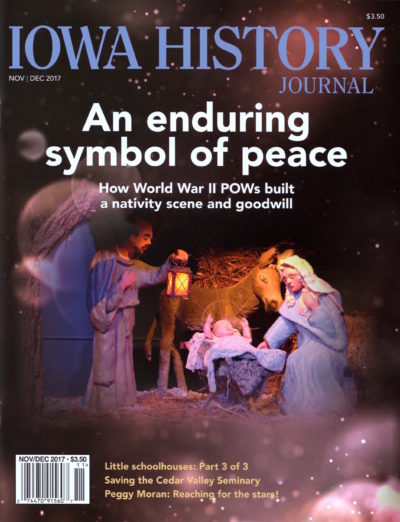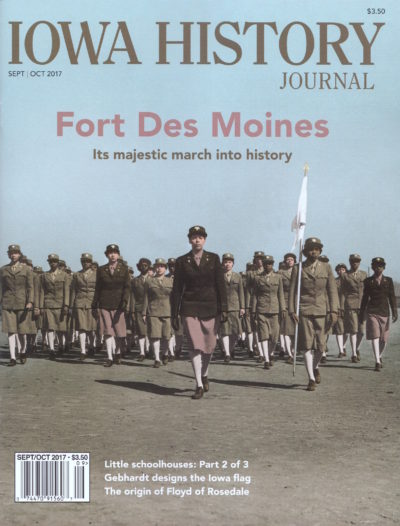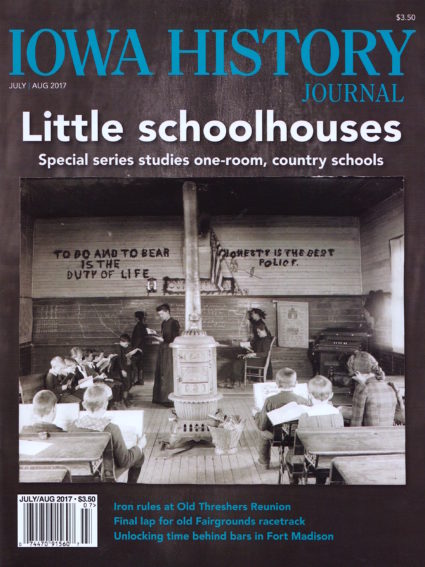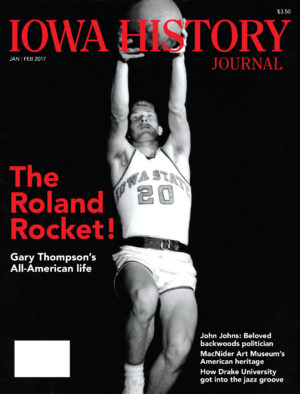
The Algona Nativity Scene was created by German prisoners of war at Camp Algona during World War II. The POWs built it in time for Christmas in 1945 and when the war ended, they donated it to the town as a gesture of goodwill. It includes 65 figures and is under the care of the Algona First United Methodist Church. Photo courtesy of Camp Algona POW Museum
Volume 9, Issue No. 6 Nov/Dec 2017
›An enduring symbol of peace: How World War II POWs built a nativity scene and goodwill
›Publisher’s Perspective: Iowa historical connections abound in our nation’s capital
›Reaching for the stars with Peggy Moran
›Little schoolhouses: Part 3 of 3 in a special series that studies one-room country schools.
›John Skipper chronicles how the Cedar Valley Seminary in Osage was saved from the wrecking ball.
›Arvid Huisman covers Iowa mispronunciations in IHJ Country Roads.
›What’s in a Name? Find out about Ottumwa, the ‘City of Bridges’.
›Structurally Speaking
›Book Reviews
›Historical Happenings
›Letters to the Editor
›Iowa History Journal Quiz

Women’s Army Auxiliary Corps. (WAAC) Capt. Charity Adams of Columbia, N.C., who was commissioned from the first officer candidate class and was the first of her group to receive a commission, leads her company on the drill ground at the first WAAC Training Center at Fort Des Moines in May 1943. Photo courtesy of the U.S. National Archives and Records Administration, 531334. Colorized by Kathy Downing.
Volume 9, Issue No. 5 Sept/Oct 2017
›Discover more about Fort Des Moines and its majestic march into history.
›Publisher’s Perspective: One of Iowa’s state symbols turns 50 this year.
›Exploring history celebrates Dixie Cornell Gebhart, the designer of the Iowa flag.
›Uncover the peace-making origin of Floyd of Rosedale.
›Little schoolhouses: Part 2 of 3 in a special series that studies one-room country schools.
›IHJ Country Roads takes a ride on the big yellow kid container with Arvid Huisman.
›What’s in a Name? Find out about Spencer’s famous feline and more.
›Structurally Speaking
›Book Reviews
›Historical Happenings
›Letters to the Editor
›Iowa History Journal Quiz

The interior of Bear Creek Township School in Brooklyn, circa 1893.
Volume 9, Issue No. 4 July/August 2017
›Little schoolhouses: Part 1 of 3 in a special series that studies one-room country schools.
›Publisher’s Perspective: Iowa history to be taught in public schools.
›Unlock time behind bars with the history of the old Iowa State Penitentiary.
›Discover how old iron rules at Midwest Old Threshers Reunion.
›The final lap: The history of the century-old Fairgrounds racetrack and plans for a new one.
›What’s in a Name? Take a historical journey of Creston.
›Join columnist Arvid Huisman as he recalls the day the carnival came to town.
›Book Reviews
›Historical Happenings
›Letters to the Editor
›Iowa History Journal Quiz

For our cover story, John Liepa chronicles the origins of baseball in Iowa and highlights some of the small-town players who made it to the Big Leagues, a few of whom are among his collection of rare baseball cards and photographs. Cover design by Kathy Downing.
Volume 9, Issue No. 3 May/June 2017
›Covering the bases: Baseball’s origins and small town stars.
›Publisher’s Perspective: Writers of IHJ stories who recently swept the annual Mills-Noun Awards.
›How the citizens of Long Grove gunned down bank robbers in 1921.
›Discover eyewitness accounts of the 1879 Estherville Meteorite.
›Learn about flying a World War II legend named “Gunfighter”.
›What’s in a Name? Urbandale, once known as a “streetcar suburb,” celebrates its 100th anniversary.
›Get a preview of the John Wayne Birthday Celebration in Winterset.
›Columnist Arvid Huisman recalls a mid-summer’s night memory in Iowa’s Country Roads.
›Book Reviews
›Historical Happenings
›Letters to the Editor
›Iowa History Journal Quiz

Smokey Smith, country music’s one man show in a 1950s photo. Colorization by Kathy Downing
Volume 9, Issue No. 2 Mar/Apr 2017
›Smokey Smith: Country music’s one man show
›Camp Dodge Iowa’s largest military base trained soldiers for World War I
›Was William Harding Iowa’s worst governor?
›Publisher’s Perspective: Kimball Village site designated as National Historic Landmark
›Behind the scenes with Drake’s Paul Morrison
›Iowa Country Roads
›What’s in a Name?
›Book Reviews
›Historical Happenings
›Letters to the Editor
›Iowa History Journal Quiz

Gary Thompson, a basketball and baseball superstar known as “The Roland Rocket” in the early 1950s, later became a two-sport All-American at Iowa State University, a player and coach for the Phillips 66ers in AAU basketball, a successful businessman and longtime television broadcaster. Photo courtesy of Iowa State University
Volume 9, Issue No. 1 Jan/Feb 2017
›The Roland Rocket! Gary Thompson’s All-American life
›’Things ain’t what they used to be’: How Drake University got into the jazz groove
›John Johns: Backwoods politician practiced what he preached on Iowa’s frontier
›Publisher’s Perspective: History has taught us nothing about elections and pundits
›Exploring History: MacNider Art Museum’s American heritage
›Iowa Country Roads
›What’s in a Name?
›Book Reviews
›Historical Happenings
›Letters to the Editor
›Iowa History Journal Quiz
